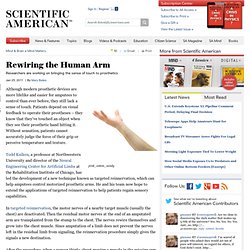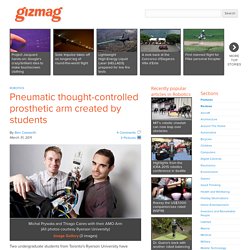

Rewiring the Human Arm. Although modern prosthetic devices are more lifelike and easier for amputees to control than ever before, they still lack a sense of touch.

Patients depend on visual feedback to operate their prostheses – they know that they’ve touched an object when they see their prosthetic hand hitting it. Without sensation, patients cannot accurately judge the force of their grip or perceive temperature and texture. Todd Kuiken, a professor at Northwestern University and director of the Neural Engineering Center for Artificial Limbs at the Rehabilitation Institute of Chicago, has led the development of a new technique known as targeted reinnervation, which can help amputees control motorized prosthetic arms. Pneumatic thought-controlled prosthetic arm created by students. Two undergraduate students from Toronto's Ryerson University have created a prosthetic arm that is controlled by its wearer's brain signals, and powered by compressed air.

Not only is the Artificial Muscle-Operated (AMO) Arm said to offer a greater range of movement than traditional prostheses, but it also doesn't require the amputee to undergo invasive surgery, is easy to learn to use, and it is relatively inexpensive to make. The AMO Arm was designed and built by Ryerson biomedical engineering students Thiago Caires and Michal Prywata. Disabled Adventurer Plans Robo-Suit Expedition. Disabled in a car accident 27 years ago, Seiji Uchida intends to ditch his wheelchair as he sets off in pursuit of a life-long dream.

Seiji Uchida, a disabled adventurer, is planning to travel to France sans wheelchair using a robot suit. The suit, called the Hybrid Assistive Limb (HAL), is designed to help the elderly with mobility. Two Research Groups Create 'Electric Skin'